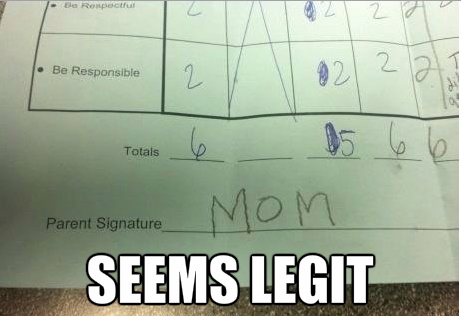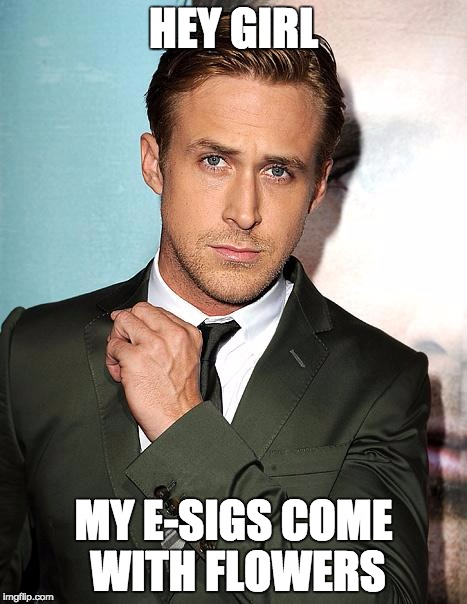
The Problem:
The point in most contracts where I start to throw up a little bit is an ancient clause that usually looks like this:
Counterparts. This Agreement may be executed in any number of counterparts, each of which when so executed and delivered shall be deemed an original for all purposes, and all such counterparts shall together constitute but one and the same instrument. A signed copy of this Agreement delivered by either facsimile or e-mail shall be deemed to have the same legal effect as delivery of an original signed copy of this Assignment, provided such original signed copy is delivered within ten days thereafter. Notwithstanding the foregoing, each party hereto shall deliver original counterpart signatures to the other parties on or before the date hereof.
Now that we got that out of the way, let’s jump back to 30,000 feet and review the point of signatures in the first place. A signature is a piece of evidence, meant to identify a party desiring to express his intent to be legally bound. We talked a few weeks ago about the origins of writing and its incredible usefulness as a technology. The invention of written contracts came with two great advantages: a) being able to close a deal remotely and b) preventing that shyster from reneging on the deal. But notice that the technology of a signature involves each party drawing amateur art next to his name as an indication of authenticity. In fact Black’s Law Dictionary defines the term ‘signature’ to mean “[a] person’s name or mark written by that person or at that person’s direction.” So a signature doesn’t even have to be your name–it could literally be a stick figure representation of your Aunt Charlotte that you have adopted to authenticate your agreements. Just take a look at the nearest contract, can you actually make out any words in the signature?
So, if the point of a signature is to prove identity and manifest assent into a record, how in the h-e-double-hockey-sticks do you know who signed the document? And why do you think a wet ink original version will give you any advantage in proving your claim? The artwork of signatures doesn’t exactly rise to the complexity of Titian or El Greco—they’re easy to forge. As someone who has litigated a few hundred forgeries, I feel obligated to tell you that it ain’t hard. One case I had involved the sale of a hospital (yes, a hospital) on the basis of forged bank documents and a fake letter of credit. The forger closed on the deal and stripped the hospital of all the scrap metal before anyone became the wiser. The most common forgeries are checks because there is an immediate payoff, and for all of the big banks’ image recognition software, they still miss a lot of forged checks. Therefore, it’s not obvious that a wet ink signature should be regarded as gospel for proof of identity and manifested intent.
Enter E-SIGN.

In 2000, the trolls in Washington Congress passed the Electronic Signatures in Global and National Commerce Act (“E-SIGN”) and most states followed with the Uniform Electronic Transactions Act (“UETA”). Even South Carolina, concerned that road construction might be delayed by the tedium of wet signature requirements, rushed to pass its own version of UETA in 2004 along with the Uniform Real Property Electronic Recording Act (“URPER”). In short, ESIGN and UETA say that electronic signatures are valid, except for a few areas like wills, adoption and foreclosures, which must be determined by individual state law. URPER covers allows for electronic recording of real estate documents.
The recognition of electronic signatures was a tremendous boon to efficiency in commerce and, I submit, a great leap forward in the technology of the signature. Instead of stick figures meant to identify the buyer, we now have an image of a drawing, the buyer’s name, the email address associated with the buyer, the geo-locating IP address from whence the electronic signature was generated and an immediate, time-stamped notification from an independent business record to the purported parties reminding them that they just entered into a deal under the terms laid out in the attached document. Which pile of evidence would you rather rely on in court?
Brass Tacks
So, what does all this mean for you, the hard working business owner or street lawyer?
- Stop using wet signatures unless they are specifically required by the exceptions to ESIGN, UETA OR URPER. It is costing you a tremendous amount of time and money. And, contrary to popular belief that shyster really will show up in court and deny that the wet ink amateur art on the page was really his.
- Adopt an electronic signature platform with an open API and an intuitive mobile interface. We use HelloSign, but there are lots of good options like Adobe Sign, DocuSign and RightSignature. Just make sure the platform integrates (plays nicely) with whatever software you use to run your business.
- Build templates of the documents that you use most often, like form contracts and waivers.
- Use all the new free time you have without wet signatures to do something nice for your neighbor, help a friend or visit the elderly. It’s a round world after all.




